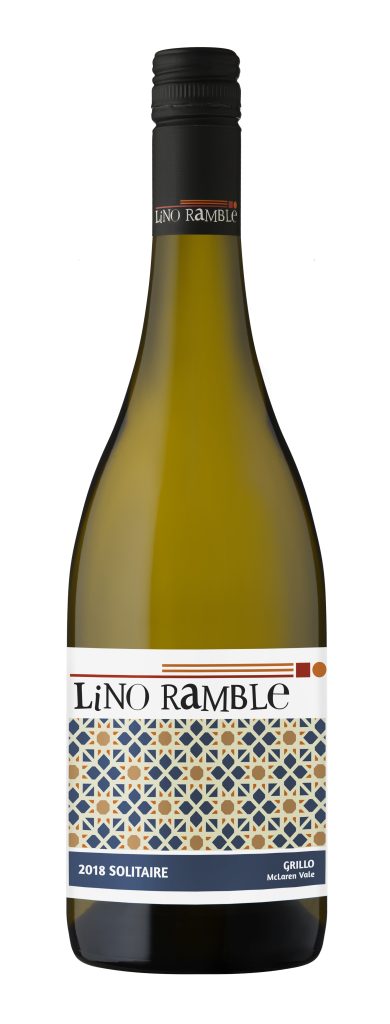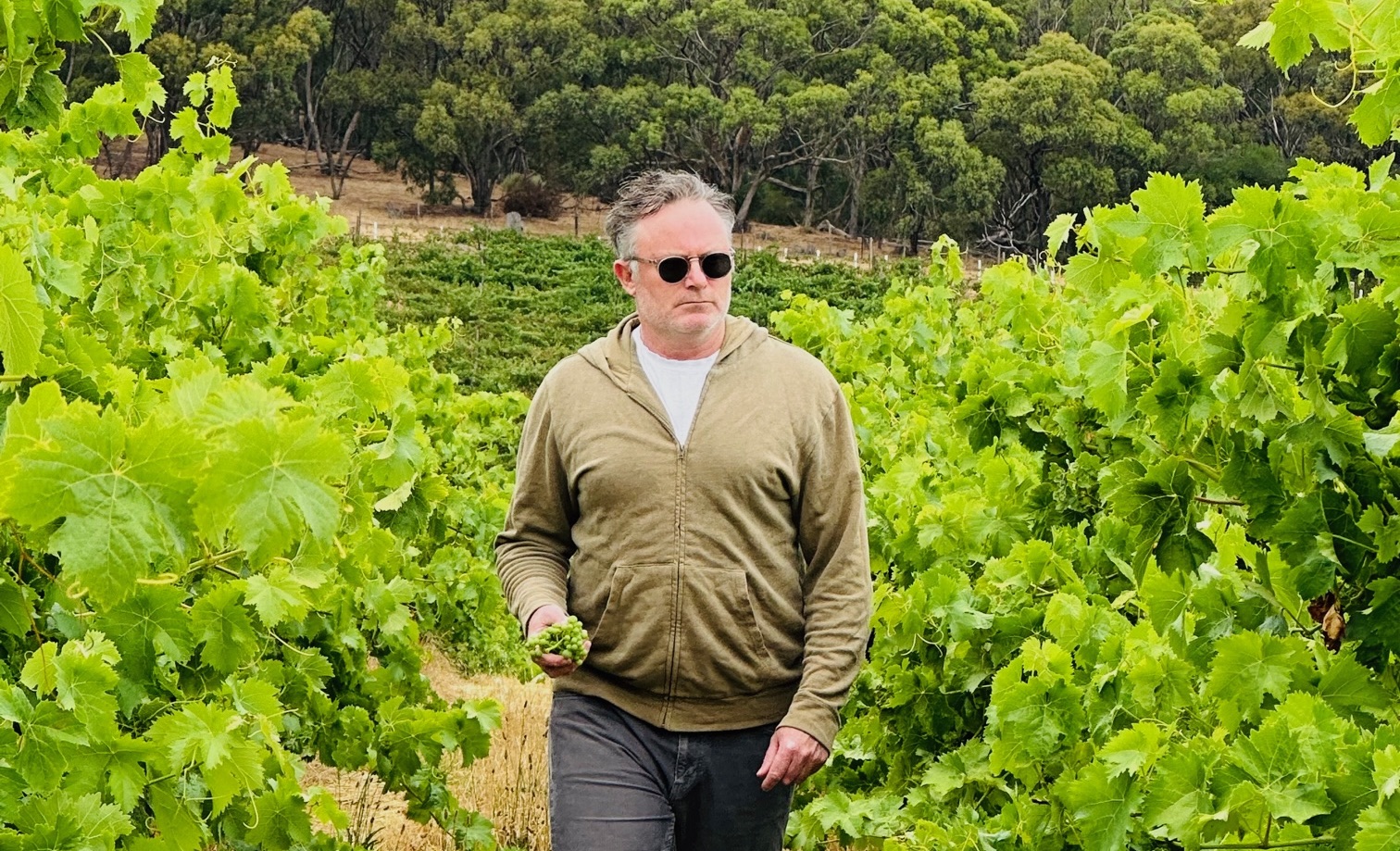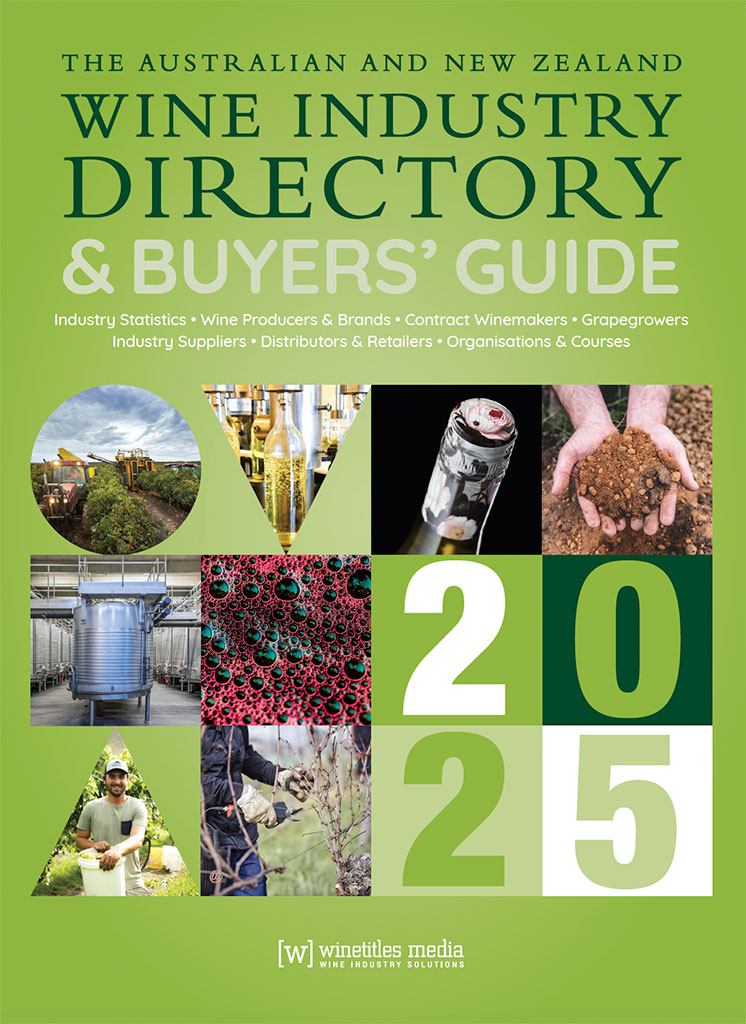Andy Coppard in Grillo vines
Grillo takes the heat to produce fresh, crisp white in McLaren Vale
By Andy Coppard, Lino Ramble, McLaren Vale, South Australia
Lino Ramble was born in 2012 from two like-minded weirdos Angela Townsend and Andy Coppard. We came from very different backgrounds. Ange had worked in disability, myself in various winemaking/viticulture jobs from Margaret River, France and, in recent times, McLaren Vale. However, we both had similar tastes in wine: fresh, crisp white wines and lighter-style reds that could potentially be served chilled — not something McLaren Vale had historically based its reputation on, but that was never going to stop us.
There were some non-negotiables from the outset: a focus on varieties that were suited to our warm, dry climate (so a crisp, racy Margaret River Chardonnay was out of the question). Grenache was a no-brainer, both from a sustainability sense and because stylistically it ticked all our boxes — fresh, fruit-driven and, with a bit of chill, perfect on a hot summer’s day. Finding some decent white varieties proved to be a little trickier such was the lack of available fruit at that time (10+ years later the choices available are much greater). Fortunately, we managed to get our hands on a hatful of Roussanne, Marsanne and Viognier in 2012 to go with a Grenache blend and we were away.
Additionally, we wanted the fruit, irrespective of variety or style, to be the star of the show and the mad buggers brave enough to plant them — single-vineyard, site specific to suit the attributes of the particular variety. As luck would have it, McLaren Vale’s myriad locations was perfectly suited for us to pick and choose a range of different micro-climates and matching geologies. And so it was with Grillo, native to Sicily whose south coast from Siracusa to Palermo is climatically very similar to that of McLaren Vale. There is always an element of risk associated with planting something new. We obviously had no history with it at all in McLaren Vale. We did, however, have history with Nero d’Avola from the similar locales as Grillo. We have sourced Nero from White’s Valley in McLaren Vale since 2014 and it has proven to be ably suited to our conditions. We also had the stylish wines of Andrew Cottell from Parish Hill as inspiration (Grillo being one).

DNA analysis suggests that Grillo is a cross between Catarratto (Sicily’s most widely planted variety) and Zibibbo (Muscat of Alexandrina). There is written evidence of its existence dating back to the 19th century. Its reputation for being able handle hot, dry conditions is well documented. Anyone who has visited the provinces of Palermo and Trapani during summer will attest to that.
Working with our good friends Matthew Hatwell and Jonathon (Jock) Harvey, vines were planted in 2015 and 2016 at Chalk Hill Viticulture’s Lanark Vineyard located at the top of Chapel Hill Road in Blewitt Springs. The site is east facing with an elevation of 165 metres above sea level at its highest point. Soil composition varies significantly across the one-hectare planting from grey sandy-loam at the top to a Stonyfell quartzite at the bottom. Row orientation is east-west facing. Planting material was sourced from John Gilbert who had personally imported the variety into Australia via the Australian Vine Improvement Association from the Mazara del Vallo sub-region of Trapani in Sicily. Compared to the Malbec and Shiraz planted alongside the original planting at the same time, Grillo won the race to fill out the cordon wire at a canter.
Planting density is standard for the region at 1666 vines per hectare and pruned in a traditional VSP manner. Now that we are getting some good vine age it’s fair to say the variety does not struggle to grow a canopy. Using Shiraz as a yardstick, the requirement for supplementary water applied via under-vine drippers is considerably less. A less-is-more approach to irrigation is a valid point to make. To date (mid-January 2023) water use is nil and shoot tips on most vines are still active. While Grillo has an affection for McLaren Vale’s climate we have discovered the hard way during the 2022-23 growing season that it doesn’t love downy mildew. While the site has excellent exposure and good airflow we have been forced to adjust the spray program accordingly.

We harvested 1.5 tonnes of fruit in 2018 off the first 12 of 20 rows planted in 2015. The KISS (keep it simple stupid) approach was employed the first year to best assess what it was we were dealing with: wild fermentation in old (neutral) French oak, no added acid or enzymes, free run and pressings kept separate initially. The juice had amazing aromatics of lychee, citrus blossom and (I’m not joking) Life Savers musk-flavoured lollies from our childhood — completely different from anything we had ever played with before. The only disappointment in that first vintage was that it didn’t have a particularly high level of natural acid, something the variety has a reputation for. Final alcohol was 11.8%v/v, pH3.6 and TA of 5.6g/L.
The 2022 vintage of our Solitaire Grillo is about to go to bottle a month after being barrel-fermented and matured in neutral French oak for 10 months. Final alcohol is 13.6%v/v, pH3.35 and TA of 7.05g/L. It has also completed MLF to add complexity and tone the acid down — we were dealing with sparkling base numbers prior. While the 2021-22 growing season was notable for its mild conditions (we didn’t have one day above 40°C), naturally high levels of acid similar to those above have been a common theme for the last three vintages irrespective of how hot and dry it got. The wine, as with all vintages since 2019, spends 48 hours on skins post-destemming, gently hand plunged in a cool room before free run and pressings are combined and transferred to oak with full solids. Fermentation with indigenous yeasts has thus far never given us any grief. Lees stirring periodically throughout maturation is also commonplace.
It must be noted that bentonite additions have always been significantly higher compared to the other whites we make. Our Fiano spends considerably longer on skins (90 days) and is also barrel fermented/matured etc and uses less than half the rate of bentonite. Arinto and Pinot Grigio are a fraction.
The varietal flavours we are consistently seeing each year are honeysuckle, white peach, citrus and a sea-spray or oyster shell minerality. It pairs beautifully with seafood, shellfish in particular, or haloumi straight off the grill with a squeeze of fresh lemon juice.
We are proud to be the first producer of Grillo in McLaren Vale and delighted to play a small part in adding an extra layer to the flavour profile of an incredibly diverse region. The future of climate-appropriate varieties, particularly whites, is very exciting. Demand for Fiano over recent years has been exceptional and we look forward to seeing similar growth in Grillo as consumer awareness and appreciation increases with time.
Grillo
Background
The earliest record of Grillo (grill-YOH) was in 1873 in Sicily. DNA research has revealed that it is the natural offspring of Catarrato Bianco (an old Sicilian variety) and Muscat of Alexandria (syn. Zibibbo in Sicily). For this reason, Grillo is most likely to be Sicilian in origin. After phylloxera reached Sicily in the 1880s, Grillo was used to replace Catarrato Bianco. It is mainly restricted to Sicily and principally grown in the north-west, particularly in the province of Trapani where it is the main component of DOC Marsala. Grillo is used as a single variety in the DOCs of Alcamo, Contea di Sclafani, Delia Nivolelli, Erice and Monreale; and as a component in blends in other DOCs. In recent times DNA research has revealed that Rossese Bianco grown in Liguria is actually Grillo. Other synonyms include Ariddu and Riddu. The global area (2016) was 6295ha (98% in Italy). Grillo is a relatively recent import to Australia and there are currently fewer than 10 wine producers (Adelaide Hills, McLaren Vale and Barossa Valley).
Viticulture
Budburst is early and maturity is mid-season. Vigour is moderate to high with erect growth habit. Bunches are medium, loose to well-filled with medium berries. Yield is moderate. It is reported to be both drought and heat tolerant but more susceptible to oidium than average. There is clonal variation in both vigour and bunch size.
Wine
Table wines are crisp and savoury with good structure. Lighter styles have citrus blossom and peach notes, while more aromatic types may have passionfruit, grapefruit and herbs.
For further information on this and other emerging varieties, contact Marcel Essling at the AWRI ([email protected] or 08 8313 6600) to arrange the presentation of the Alternative Varieties Research to Practice program in your region.


















